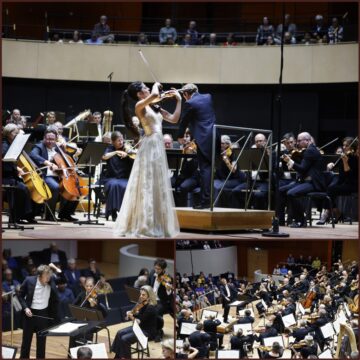Serge Koussevitzky once referred to this work as the “Finnish Parsifal,” and the climax of the piece seemed to announce the appearance of a magical object. It might not have been the Grail that Sibelius had in mind but rather the “Sampo.” In Finnish mythology, the Sampo was a magical artifact, a mill capable of creating gold, silver, and grain from nothing, defying the laws of physics. The Seventh Symphony, in its own way, achieved a similar miracle. It started from silence and contemplation, sculpting moments of sheer grace, from the robust bassoons to the flawless and deeply engaged oboes. It built up to the revelation of the magical object, represented by the high registers of the violins, before settling into the tranquility of its final measures. It was a musical portrayal of “the azure, the azure, the azure,” in the words of Mallarmé, reflecting the shimmering waters of Lake Lahti under the fading September sun.
María Dueñas, with her exceptional intelligence, astonishing flexibility, and breathtaking technique, engaged in a passionate dialogue with the orchestra. Her mastery of nuances, from delicate pianissimos to breathtaking crescendos, revealed that her performance transcended mere virtuosic technical prowess. Her playing was imbued with soul, ardor, generosity, and passion. The orchestra responded with increasing vibrancy, with impressive brass and a refusal of legato, balanced with moments of suspended time reminiscent of Wagner’s Parsifal. The ensemble’s excellence prompted spontaneous applause at the end of the breathtaking Allegro moderato. It left the audience with tears in their eyes and shivers down their spines. It was a musical wonder.
As an encore, María Dueñas treated the audience to a virtuosic piece, Applemania by the contemporary Russian-Austrian composer Aleksey Igudesman. This composition showcased the violin’s most challenging aspects, and it was met with thunderous applause. Dear friends, I can say that you have here the Martha Argerich of the violin.
Sibelius crafted a captivating program for his Stockholm concert, bookended by two remarkable symphonies. He commenced with Symphony No. 7, tracing the roots of his musical language, and concluded with the First Symphony, Op. 39. While the latter was more classical in structure, it already hinted at Sibelius’s unique style.
The beautiful clarinet solo that opened the First Symphony set a sinuous and elegant tone, creating a sense of narrative absent in the Seventh Symphony. The orchestra, with its full and rich sounds, was accompanied by powerful trombones. Harding adeptly balanced the epic and intimate elements. At times, the attentive ear could discern hints of Bruckner, whom Sibelius greatly admired. The dialogue between the harp and clarinet even revealed echoes of Sibelius’s future symphonic poem, The Bard, characterized by its incantatory repetitions.
The Andante, despite a slightly imprecise horn attack, showcased the orchestra’s impeccable string section, excelling in pianissimos. They provided a backdrop for a melody reminiscent of the haunting “kantele” a traditional Finnish plucked-string zither. María Dueñas’s performance continued to impress, marked by character, infinite nuances, and exceptional technical and emotional capabilities. The orchestra, clearly comfortable with this music, supported her beautifully.
The final movement, Allegro, ma non tanto, was a triumphant gallop. It featured divine high notes, meticulously crafted clarinets, elegant brass, and admirable flutes that complemented the formidable technical challenges mastered by the violinist. The audience held their breath until the triumphant conclusion.
In conclusion, the Lahti Sibelius Festival offered a captivating journey through Sibelius’s musical world. With a splendid orchestra that produced majestic sounds and a conductor who paid due homage to Sibelius’s musical heritage, one could only hope to hear more from Daniel Harding in this musical realm. This festival reaffirmed its reputation as a top-tier event in the world of classical music.
Philippe Rosset
September 8, 2023



